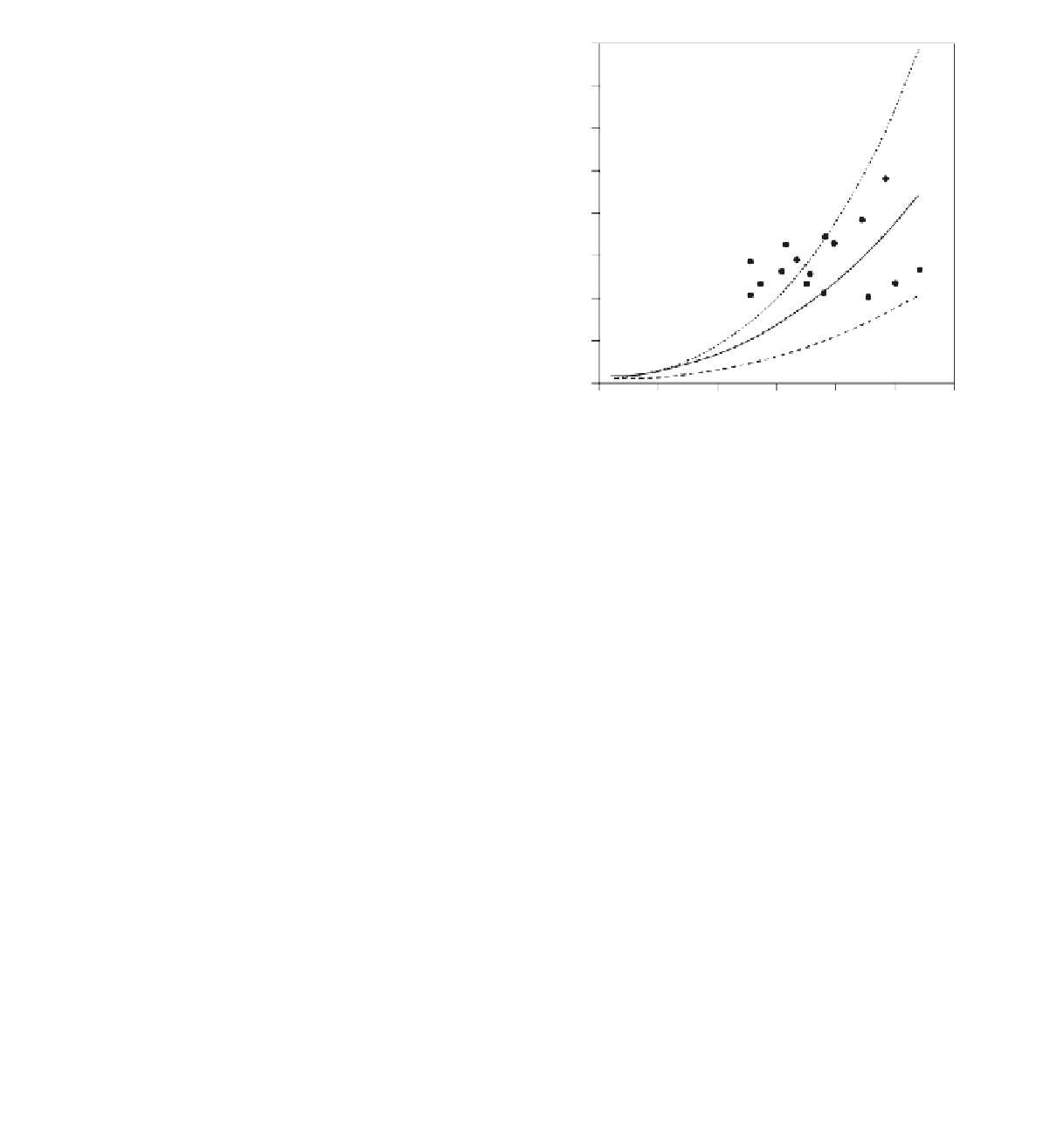Geoscience Reference
In-Depth Information
threshold term (
u
∗
ct
), despite the fact that it is also likely
to have an important effect on the transfer of momentum
on grain impact.
Zingg (1953) followed a similar argument to Bagnold
(1941) but used a
3
160
Measured rate
Bagnold (1941)
Lettau & Lettau (1978)
Zingg (1953)
140
120
/
4
power function:
100
D
)
3
/
4
u
3
q
=
C
2
(
d
/
∗
ρ/
g
(18.12)
80
where
60
C
2
=
constant (0.83)
40
Owen (1964) found that this expression was more accu-
rate over a wider range of particle sizes than the Bagnold
(1941) formula, but it still omits a term for the threshold
of entrainment. Such a term was incorporated into a later
analysis of Bagnold (1956), which was subsequently re-
fined by Lettau and Lettau (1978) into a very commonly
used expression:
20
0
0.2
0.3
0.4
0.5
0.6
0.7
0.8
Shear velocity (
u
*
)
Figure 18.22
Relationship between shear velocity, measured
sand transport rate and that calculated from three sand trans-
port rate formulae (after Wiggs, 1992).
D
)
0
.
5
(
u
∗
−
u
∗
ct
)
u
2
q
=
C
3
(
d
/
∗
ρ/
g
(18.13)
where
thin vertical design (hence presenting a minimum distur-
bance to the wind flow) and incorporate the bleeding of air
from within the trap to reduce backpressure. The sampling
efficiencies of the various types of trap vary considerably
and have been reported to be as low as 20 % (Knott and
Warren, 1981) and as high as 70 % (Gillette and Goodwin,
1974; Marston, 1986). However, the determination of ef-
ficiencies is fraught with problems and Jones and Willetts
(1979) have shown that small differences in the operation
of traps in the field may give rise to large contrasts in
efficiency.
Substantial improvements in sampling efficiency have
been provided by the incorporation of wings extending
downwind from trap openings, giving the trap a wedge-
shaped appearance (Figure 18.23). This further decreases
backpressure and allows sand flux collectors to become
almost isokinetic in terms of their flow characteristics
(Nickling and McKenna-Neuman, 1997). While these de-
signs have achieved near 90 % sampling efficiencies in
wind tunnel tests their performance in the field is severely
restricted by their sensitivity to the incident angle of the
wind. Nickling and McKenna-Neuman (1997) report that
incident angles as low as 5
◦
, which may occur frequently
during periods of measurement, severely reduce the sam-
pling efficiency of such traps (McKenna-Neuman, Lan-
caster and Nickling, 2000; Namikas, 2003).
More recent attempts to characterise saltation activity
in the field have involved the use of saltation impact re-
C
3
=
constant (4.2)
Despite this array of transport equations, no specific model
has proven to be broadly applicable under a variety of nat-
ural environmental conditions. This is partly because the
majority of published models have been derived from the-
ory or experimentally from wind tunnel observations with
homogeneous sediment beds (Spies, McEwan and Butter-
field, 1995; Butterfield, 1999; Bauer, Houser and Nick-
ling, 2004), without sufficient testing or development in
the field. Field testing that has been accomplished (Sarre,
1987; Sherman, 1990; Wiggs, 1992) has shown a great
deal of variation between the observed rates and those
predicted as a function of
u
∗
(Figure 18.22). Given the
natural variability and complexity over short spatial and
temporal scales in grain size, moisture status, bedslope
and wind conditions, as previously described, such weak
relationships are not surprising.
Furthermore, field calibration of sediment flux equa-
tions is severely hampered by the errors inherent in mea-
suring sand flux in the field. In order to measure the sand
transport rate, a collecting device has to be inserted into
the airflow for a known period of time. This inevitably
causes airflow disturbance and hence error in flux mea-
surement. Two major problems with sand traps are those
of back pressure and scouring of sand around the base of


